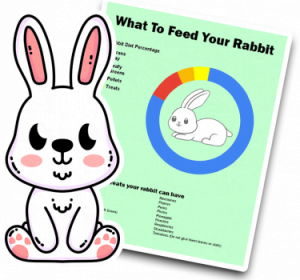
You should store your hay in a dry & dark location to prevent mold, you should leave your hay in a container/plastic bin which prevents moisture from getting to your rabbit’s food.
Hay can get messy if not stored correctly, it can get hard to decide where and how to keep hay as we may need to top it up several times a day. In this article, we will provide you with a comprehensive guide on how to store rabbit hay correctly.

Hay is a significant source of fiber for rabbits, and it should always be readily available. However, improper storage can lead to mold growth, dust, and other contaminants that can affect the health of your bunny.
Additionally, poorly stored hay can lose its nutritional value, leading to health problems and reduced longevity in your rabbit.
Rabbits have over 17k taste buds and can be very picky eaters. Hay makes up about 80% of a rabbit’s diet, but what do you do when the rabbit is not eating hay? That’s probably because hay does not taste appetizing to your bunny due to spoilage.
Mold and bacteria that can harm your rabbit will grow on hay without preservatives when its moisture levels are above 14 – 15%. Unfortunately, this only further accelerates mold growth as it produces heat.
The ideal container for storing hay is a plastic bin with a tight-fitting lid. The bin should be large enough to hold the hay you need for a week or two. Avoid using paper bags, as they can easily tear, and moisture can seep in.
Hay should be stored in a cool, dry place. If hay gets wet, it can develop mold, which is harmful to your rabbit. Make sure the storage area is well-ventilated to prevent moisture buildup.
It’s best to store hay in the dark, away from the UV rays of the sun, to avoid damaging it. You can also keep it in dry places with good ventilation or open containers.
Keeping the hay sealed tightly in a lot of humidity can cause damage because of no ventilation. Hay contains natural moisture, and preventing air from getting to it results in mold and inedible food development.
Placing hay directly on the ground can attract pests, and moisture can seep in, causing mold growth. Store the hay on a shelf or a stand to keep it off the ground.
Before adding new hay, make sure the storage container is clean and dry. Any leftover hay or debris can attract pests and lead to mold growth.
On regular days, you cannot store hay outdoors. You can store hay under a cover, as the dew and snow can cause the hay to rot.
The sunshine can keep the hay dry, so you should dry the rabbit hay first and then store it in a closed place with a roof/covering.
While storing hay in a plastic bag is possible, it is not recommended. Plastic bags do not allow for air circulation, which can cause moisture buildup and mold growth. Additionally, plastic bags can easily tear or puncture, exposing the hay to moisture and contaminants.
It’s best to store hay in a well-ventilated container, such as a plastic bin with a tight-fitting lid, or stack it in a dry, well-ventilated area, such as a barn or shed. Proper hay storage is crucial to ensure the hay remains fresh and nutritious for your livestock or pets.
By following the proper storage guidelines, you can ensure that your hay stays in good condition and remains safe for your animals to eat.
Here are some additional tips to keep in mind when storing rabbit hay:
Remember to choose the right type of hay, keep it dry and away from sunlight, store it off the ground, and keep the storage container clean.
By following these simple steps, you can ensure that your bunny always has access to fresh, nutritious hay. I hope our tips on how to store rabbit hay helps you protect your rabbit’s food for a longer period!

By entering your email address you agree to receive emails from Cottontailclub. We'll respect your privacy and you can unsubscribe at any time.